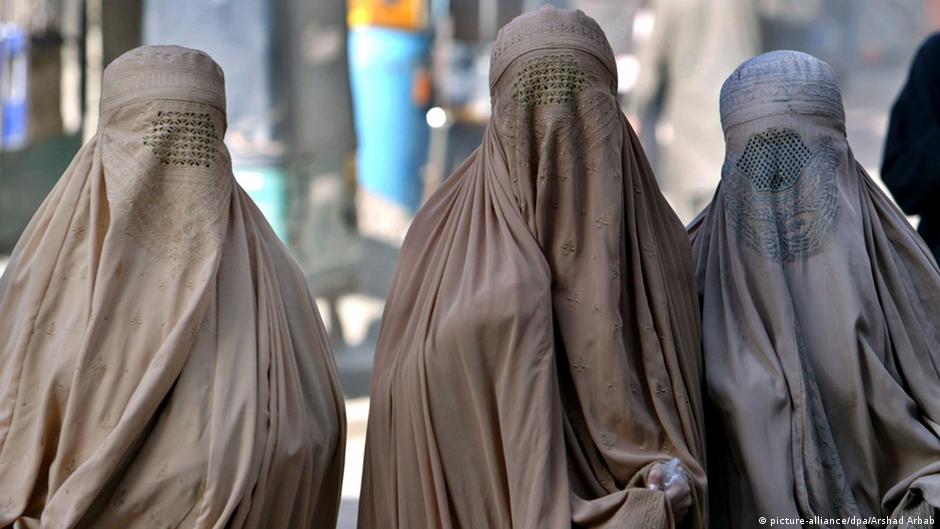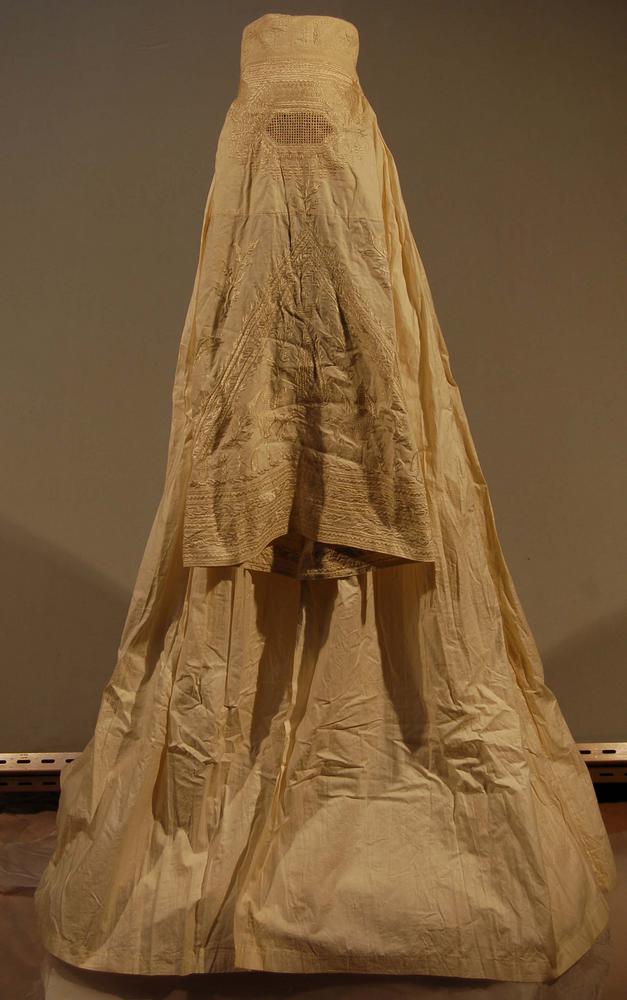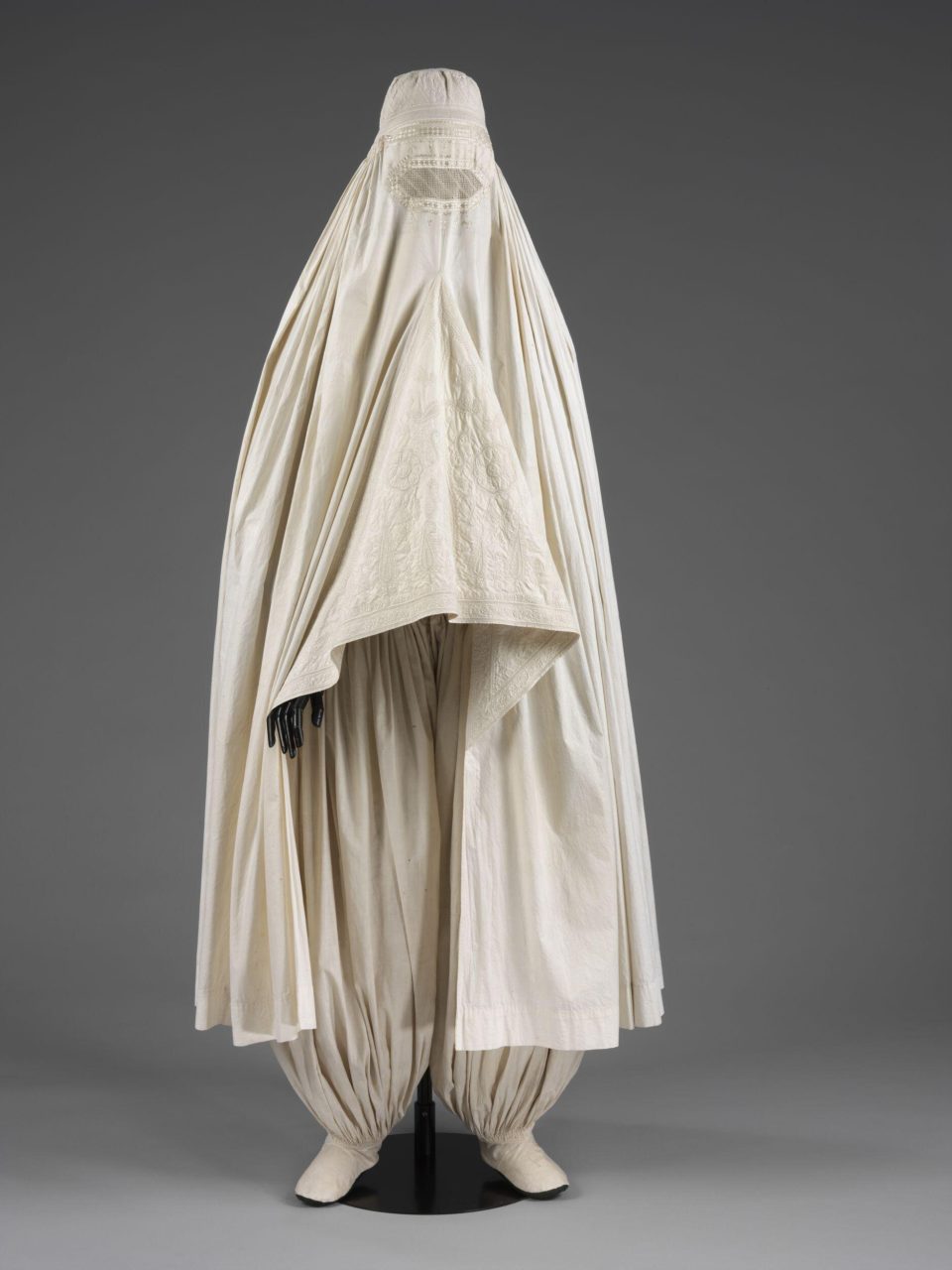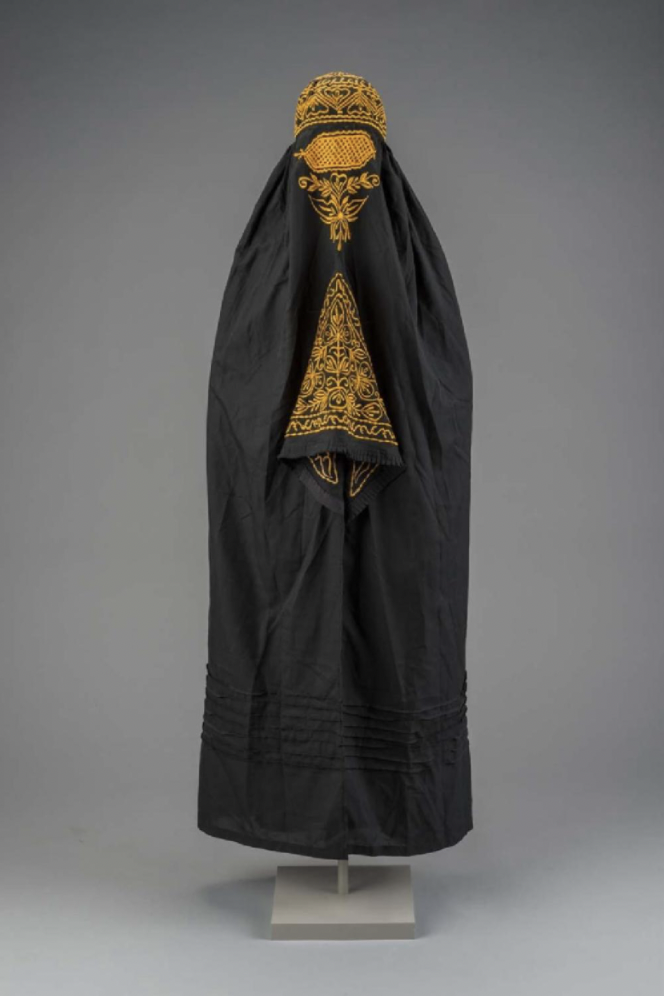An outer garment worn by Muslim women that covers the entire body, often with a cutout or mesh at the eyes.
The Details
Sara and Tom Pendergast define the burqa in Fashion, Costume, and Culture (2004) as:
“A long, flowing garment that covers the whole body from head to feet, the burka, also known as burqa or abaya, is an important part of the dress of Muslim women in many different countries. Some burkas leave the face uncovered, but most have a cloth or metal grid that hides the face from view while allowing the wearer to see” (76).
A burqa with a style of mesh cutout for the wearer to see can be seen in figure 1. This older Afghani burqa at the British Museum shows how the garment used to be made along with a diamond shape style of eye mesh for the wearer.
With a similar diamond style eye cutout, the burqa in figure 2 is a full ensemble along with pants and shoes, giving an example of how the garment could be worn. The entire body–including head, hands, face, and ankles–is covered.
In Daniel Delis Hill’s History of World Costume & Fashion (2011), the burqa is described in further detail along with the different styles and materials chosen in parts of Western Asia:
“The full Arabic ensemble that covers the woman head to toe, including a veil that exposes only the eyes, is known as a burqa. The term has become a generic label in mass media for any veiled body covering worn by Muslim women globally, although the Arabic word actually applies only to the styles of the Middle East. Not only do the terms for veiling differ among Islamic ethnic groups and regions, but the forms and aesthetics are equally varied.
The full face mask of the burqa that covers all except the eyes is still prevalent among Bedouin and rural village women. The construction, shape, and decoration of these masks remain unique to certain ethnic groups generation after generation. Some styles of the burqa mask are made of pieced leatherwork and feature only almond-shaped slits for the eyes. The leather can be polychromed with intricate patterns or can be affixed with coins, cowrie shells, mother-of-pearl buttons, beads, and silver or brass ornaments” (177).
The black and gold embroidered burqa seen in figure 3 is a more recent example of a burqa, dating between 1980 and 1985. From Saudi Arabia, this piece exemplifies some decorative details that may adorn burqa. Many burqa seen today resemble those seen on the women in figure 4; that shade of blue is a commonly seen color. There is a misconception that all burqa are black–it is an available color option, but burqa come in a wide variety of colors and patterning.
The V&A museum explains how the burqa (Fig. 2) was worn in 19th-century Iran and Afghanistan:
“Muslim women were usually fully veiled when they went out in public. They wore an outer layer over their indoor clothing and covered their faces. In Iran, this was often a sheet of dark blue or black textile (chador) worn with a white face-veil (ru-band) attached separately. This white cotton burqa from Afghanistan however, combines both elements. It has embroidered openwork over the eyes. Women would have worn the burqa with matching loose-footed trousers (chaqchur), with their skirts tucked inside. This outfit was worn with heeled slippers or boots.”
The burqa is often used interchangeably with the chadari (also chadri or chadaree), although they are different garments from different regions. Gillian Vogelsang-Eastwood’s article, “The Chadari/Burqa of Afghanistan and Pakistan” for Berg Encyclopedia of World Dress and Fashion, goes into detail to define the burqa in contrast to the chadari:
“In the twenty-first century, a burqa from Pakistan consists of a cap, a cape section (body covering) that incorporates an eyehole grid, and a separate panel lower down at the front. The cap, face-veil section, and panel are usually decorated with embroidery. This type of garment does not have the tight, pressed pleats of the Afghan version. Instead, soft pleats or gentle folds are fashioned by gathering the excess material of the chador on a draw thread and then sewing the material to the cap. The folds are created by working several rows of running stitches or by smocking the cloth to create a honeycomb effect.
The Afghan chadari consists of a cap, body covering, and a separate face-veil panel. In contrast to the (Pakistani) burqa, the panel with an eye grid is attached to the cap, and there is no separate, inserted panel lower down. The cap and panel are normally decorated with embroidery. Around the upper part of the chador, there are hundreds of narrow pleats that are gathered together and sewn onto the cap. These pleats give the garment its voluminous nature. This type of chadari has become a global icon and (in)famous throughout the world.”
A good example of the burqa with gathered chador material sewn onto the cap can be observed in figure 5. This burqa from the collection of the the British Museum has two square mesh windows for the eyes, and the hood is gathered and sewn onto the cap.
Fig. 1 - Maker unknown (Afghanistan). Burqa, Date unknown. Cotton, silk; 155x100 cm. London: British Musuem, As1986,Q.58. Source: British Museum
Fig. 2 - Maker unknown (Afghanistan). Burqa, 1800-1880. Cotton, silk embroidery. South & South East Asia, IS.23:1-1889. Source: V&A Museum
Fig. 3 - Maker unknown (Bedouin, Saudi Arabia). Burqa, 1980-1985. Cotton. Boston: Museum of Fine Arts, 2014.446. Gift of Dawn Nordblom in memory of Rodger P. Nordblom. Source: MFA Boston
Fig. 4 - Maker unknown (Afghanistan). Women wearing burqas in Kabul, 2013. Source: Wikimedia Commons
Fig. 5 - Maker unknown (Morocco/India). Burqa, 1974. Cotton; 158x100 cm. London: British Museum, As1974,28.13. Source: British Museum
Its Afterlife
In recent years, several countries in Europe have enacted bans on wearing the burqa and nijab in public. In March of 2021, Switzerland voted to ban individuals from covering their entire face in public areas. Other countries such as France, Belgium, Denmark, Austria and Bulgaria have all put forward face-covering bans. These bans have sparked outrage and continue to be a controversial issue today.
You can read more about the issue here:
Fig. 6 - Photo by Arshad Arbab. Women wearing burqas. Source: DW News
References:
- Hill, Daniel Delis. History of World Costume and Fashion. Upper Saddle River, N.J: Prentice Hall, 2011. http://www.worldcat.org/oclc/731445106.
- Pendergast, Sara, Tom Pendergast, and Sarah Hermsen. Fashion, Costume, and Culture: Clothing, Headwear, Body Decorations, and Footwear through the Ages. Detroit: UXL, 2003. http://www.worldcat.org/oclc/864002667.
-
Victoria and Albert Museum. “Burqa | V&A Explore The Collections.” Victoria and Albert Museum. Accessed March 22, 2022. https://collections.vam.ac.uk/item/O480364/.
- Vogelsang-Eastwood, Gillian. “The Chadari/Burqa of Afghanistan and Pakistan.” In Berg Encyclopedia of World Dress and Fashion: Central and Southwest Asia, edited by Gillian Vogelsang-Eastwood, 339–342. Oxford: Berg Publishers, 2010. Accessed October 09, 2021. http://dx.doi.org.libproxy.fitsuny.edu/10.2752/BEWDF/EDch5056.















